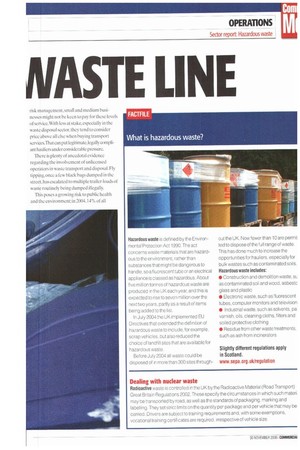What is hazardous waste?
Page 59

If you've noticed an error in this article please click here to report it so we can fix it.
Hazardous waste is defined by the Environmental Protection Act 1990. The act concerns waste materials that are hazardous to the environment, rather than substances that might be dangerous to handle. so a fluorescent tube or an electrical appliance is classed as hazardous. About five million tonnes of hazardous waste are produced in the UK each year, and this is expected to rise to seven million over the next two years, partly as a result of items being added to the list.
In July 2004 the UK implemented EU Directives that extended the definition of hazardous waste to include, for example. scrap vehicles, but also reduced the choice of landfill sites that are available for hazardous waste.
Before July 2004 all waste could be cisposed of in more than 300 sites through out the Uk. Now fewer than 10 are permit ted to dispose of the full range of waste. This has done much to increase the opportunities for hauliers. especially for bulk wastes such as contaminated soils. Hazardous waste includes: • Construction and demolition waste, as contaminated soil and wood, asbestc glass and plastic • Electronic waste, such as fluorescent tubes, computer monitors and television • Industrial waste, such as solvents, pa varnish, oils, cleaning cloths, filters and soiled protective clothing • Residue from other waste treatments. such as ash from incinerators Slightly different regulations apply in Scotland.
www.se pa .org. ukiregu lati on
Dealing with nuclear waste
Radioactive waste is controlled in the UK by the Radioactive Material (Road Transport) Great Britain Regulations 2002. These specify the circumstances in which such matert may be transported byroad, as well as the standards of packaging, marking and labelling. They set strict limits on the quantity per package and per vehicle that may be carried. Drivers are subject to training requirements and, with some exemptions, vocational training certificates are required, irrespective of vehicle size.


















































































































































































